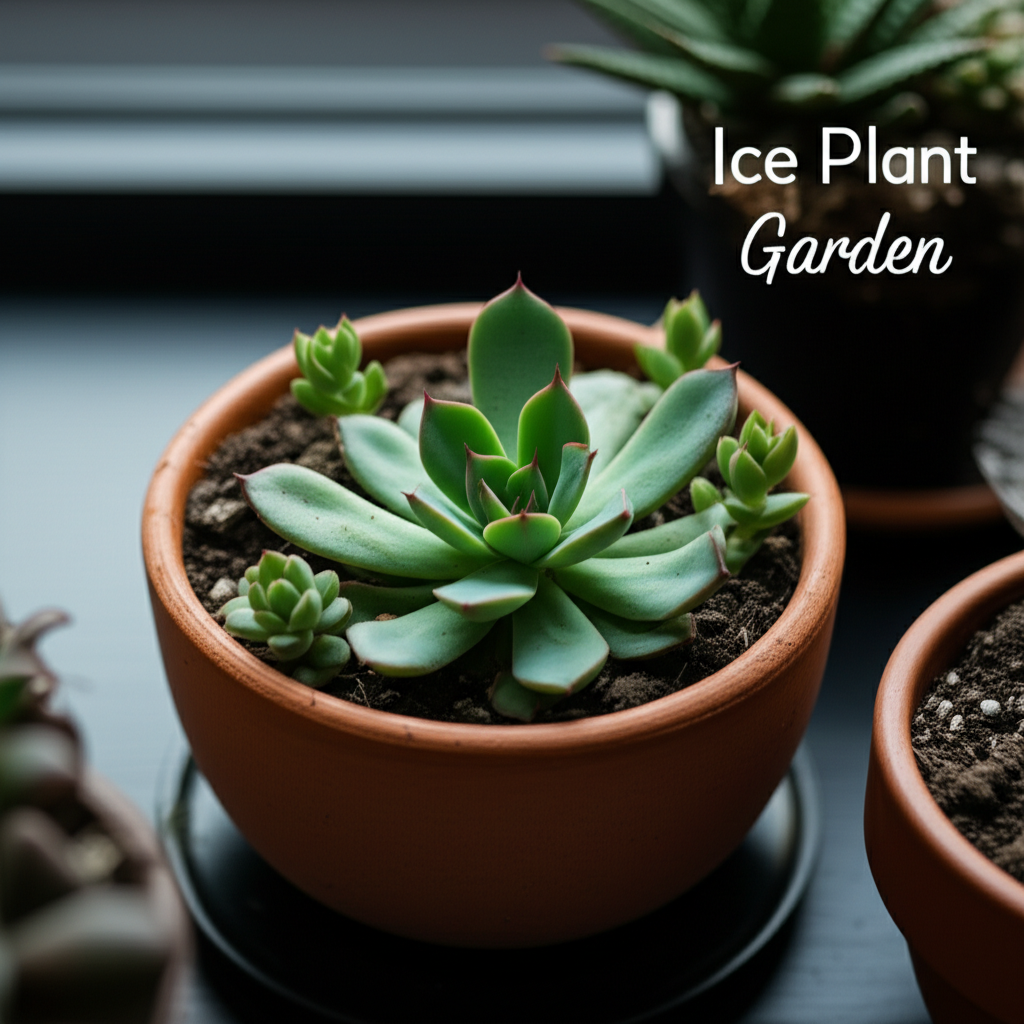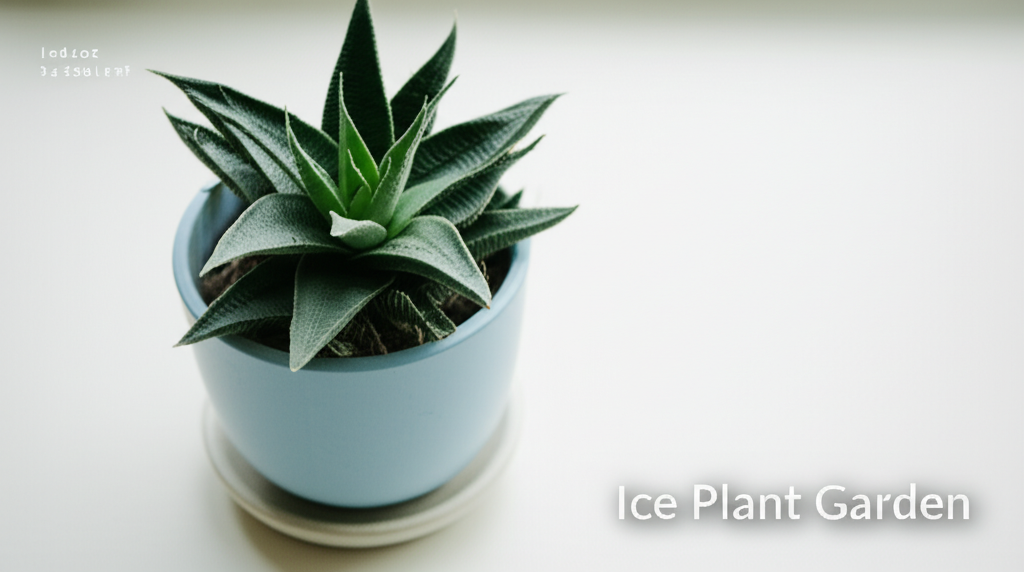The Allure of the Ice Plant: A Stunning Addition to Your Indoor Oasis
Ice plants, scientifically known as Mesembryanthemum, are a fascinating group of succulents celebrated for their unique crystalline “bladders” or “cells” that cover their leaves and stems. These specialized epidermal cells refract light, giving the plants a shimmering, dew-kissed appearance reminiscent of ice. This captivating aesthetic makes them an incredibly desirable addition to any indoor garden, particularly for creating an eye-catching table garden. Beyond their visual appeal, ice plants are relatively low-maintenance, thriving in environments that mimic their native arid South African habitats. This guide will walk you through every step of setting up and maintaining a thriving ice plant succulent indoor table garden, transforming your tabletop into a miniature desert landscape.
Why Choose Ice Plants for Your Table Garden?
The choice of succulents for an indoor table garden is vast, but ice plants offer a distinct advantage:
- Unique Visual Appeal: The characteristic “ice” droplets are unlike any other succulent, providing a constant source of fascination and beauty.
- Compact Growth: Many ice plant varieties remain relatively small and manageable, making them ideal for contained tabletop arrangements.
- Drought Tolerance: As succulents, they are naturally adapted to store water, requiring infrequent watering, which is perfect for busy individuals or those new to plant care.
- Sun-Loving Nature: They thrive in bright light, making them excellent companions for windowsills or well-lit areas.
- Variety of Forms: From trailing varieties to upright growers, there’s an ice plant to suit different aesthetic preferences and arrangement styles.
Planning Your Ice Plant Table Garden: Design and Material Selection

Before you begin planting, careful planning is crucial for a successful and aesthetically pleasing ice plant table garden. Consider the overall design, the types of ice plants you’ll use, and the necessary components.
Choosing the Right Container
The container is the foundation of your table garden. For ice plants, good drainage is paramount.
- Material: Terracotta pots are excellent choices as they are porous, allowing for better aeration and faster drying of the soil, which prevents root rot. Ceramic or glazed pots can also be used, but ensure they have adequate drainage holes. Avoid containers without drainage.
- Size and Shape: Opt for shallow, wide containers that offer ample space for the plants to spread horizontally. Bowls, shallow trays, or even repurposed containers like old wooden boxes (with added drainage) can work well. The size should be proportionate to the tabletop space you intend to dedicate.
- Drainage: This cannot be stressed enough. Ensure your chosen container has at least one drainage hole. If using a decorative pot without a hole, you’ll need to place your ice plants in nursery pots with drainage and then set those inside the decorative pot, creating a drainage layer at the bottom.
Selecting Your Ice Plant Varieties
The diversity within the Mesembryanthemum family allows for creative combinations. Consider the growth habits and visual characteristics of different species.
- Trailing Varieties: Delosperma cooperi (Cooper’s Ice Plant) and Aptenia cordifolia (Heartleaf Ice Plant) are excellent for cascading over the edges of your container, adding a soft, flowing element.
- Upright/Bushy Varieties: Conophytum species (Living Pebbles) are fascinating, small, fused leaf succulents that resemble pebbles. Lithops (Living Stones) are another option, though they require slightly different care. For more structured growth, consider varieties like Malephora crocea.
- Color and Texture: Look for varieties with different leaf colors (greens, blues, grays) and varying degrees of “ice” coverage to create visual interest.
Essential Planting Medium and Drainage Layers
A well-draining soil mix is non-negotiable for ice plants.
- Succulent/Cactus Mix: Purchase a commercially prepared succulent or cactus potting mix.
- DIY Mix: You can create your own by combining equal parts potting soil, coarse sand, and perlite or pumice. This ensures excellent drainage and aeration.
- Drainage Layer: At the bottom of your container (if not using individual pots with drainage), add a layer of gravel, lava rocks, or horticultural charcoal. This prevents the soil from becoming waterlogged.
Setting Up Your Ice Plant Table Garden: Step-by-Step
With your planning complete and materials gathered, it’s time to bring your vision to life.
Step 1: Prepare Your Container
If your container has drainage holes, you’re ready to proceed. If you’re using a pot without drainage, place a layer of gravel or LECA (lightweight expanded clay aggregate) at the bottom to create a drainage reservoir.
Step 2: Add the Drainage Layer
Pour a 1-2 inch layer of gravel, lava rocks, or coarse sand into the bottom of the container. This layer will collect excess water, preventing the soil from becoming saturated.
Step 3: Add the Potting Medium
Fill the container with your well-draining succulent/cactus mix, leaving about an inch of space from the rim.
Step 4: Arrange Your Ice Plants
Gently remove your ice plants from their nursery pots. Loosen any compacted roots carefully. Arrange the plants in the container, considering their mature size and growth habits. Place taller plants towards the back or center, and trailing varieties along the edges.
Step 5: Planting
Create small depressions in the soil for each plant. Place the ice plants in their positions and backfill with soil, gently firming around the base of each plant to secure them. Ensure the soil level is slightly below the rim of the container.
Step 6: Top Dressing (Optional but Recommended)
Add a layer of decorative pebbles, small rocks, or gravel on top of the soil. This not only enhances the aesthetic appeal but also helps to retain moisture, suppress weeds, and prevent the soil from washing away.
Step 7: Initial Watering
Water your newly planted ice plants lightly. Avoid overwatering; the goal is to settle the soil around the roots.
Caring for Your Ice Plant Table Garden: Ongoing Maintenance
Consistent and appropriate care will ensure your ice plant table garden remains vibrant and healthy.
Light Requirements
Ice plants are sun-worshippers.
- Direct Sunlight: Place your table garden in a location that receives at least 6-8 hours of bright, direct sunlight per day. A south-facing or west-facing window is ideal.
- Acclimation: If your plants have been in a shadier environment, gradually acclimate them to more intense light to prevent sunburn.
Watering
The most common mistake with succulents is overwatering.
- Drought Tolerant: Ice plants are very drought tolerant. Allow the soil to dry out completely between waterings.
- Check Soil Moisture: Insert your finger about an inch into the soil. If it feels dry, it’s time to water.
- Watering Method: Water thoroughly until water drains from the bottom of the pot. Avoid getting water on the leaves, as this can lead to fungal issues.
- Seasonal Adjustments: Water less frequently during the cooler, dormant months (fall and winter).
Temperature and Air Circulation
Ice plants prefer warm temperatures but can tolerate cooler conditions.
- Ideal Temperature: They thrive in temperatures between 65-80°F (18-27°C).
- Winter Dormancy: While not strictly necessary for all varieties, some may benefit from a cooler period (around 50-60°F / 10-15°C) during winter.
- Air Circulation: Good airflow is important to prevent fungal diseases. Avoid placing your table garden in stagnant, humid areas.
Fertilizing
Ice plants are not heavy feeders.
- Frequency: Fertilize sparingly, once or twice during the active growing season (spring and summer).
- Type: Use a diluted, balanced liquid fertilizer specifically formulated for succulents or cacti.
Pruning and Propagation
Regular pruning can help maintain the shape and encourage bushier growth.
- Pruning: Trim back leggy stems to maintain a compact appearance. You can also prune to remove any dead or damaged foliage.
- Propagation: Ice plants are easily propagated from stem cuttings. Simply take a cutting, let it callus over for a few days, and then plant it in well-draining soil.
Troubleshooting Common Issues in Your Ice Plant Table Garden
Even with the best care, you might encounter some common problems.
Overwatering Symptoms
- Yellowing leaves that may become soft and mushy.
- Leaf drop.
- Root rot (indicated by black, mushy roots).
Underwatering Symptoms
- Leaves may appear shriveled or wrinkled.
- Reduced growth.
- Loss of the characteristic “ice” appearance.
Pests
While generally pest-resistant, ice plants can occasionally attract common houseplant pests.
- Mealybugs: Small, white, cottony insects. Remove with a cotton swab dipped in rubbing alcohol or use insecticidal soap.
- Aphids: Small, green or black insects. Blast them off with a strong stream of water or use insecticidal soap.
Key Facts and Comparison of Ice Plant Varieties for Table Gardens
The following table highlights some popular ice plant varieties suitable for indoor table gardens, comparing their key characteristics.
| Variety Name | Scientific Name | Growth Habit | “Ice” Effect | Light Needs | Watering Frequency |
|---|---|---|---|---|---|
| Cooper’s Ice Plant | Delosperma cooperi | Trailing, spreading | Moderate to heavy papillae | Full sun | Drought tolerant, water when dry |
| Heartleaf Ice Plant | Aptenia cordifolia | Trailing, groundcover | Minimal to moderate papillae | Full sun to partial shade | Drought tolerant, water when dry |
| Living Pebbles | Conophytum spp. | Clustering, small, fused leaves | Varies by species, some have rough textures | Bright, indirect light, some direct morning sun | Very drought tolerant, water sparingly in summer, more in fall |
| Purple Ice Plant | Delosperma cooperi ‘Purple’ | Trailing, spreading, with purple flowers | Moderate papillae | Full sun | Drought tolerant, water when dry |
Pros and Cons of an Ice Plant Succulent Table Garden
As with any horticultural endeavor, an ice plant table garden has its advantages and disadvantages.
| Pros | Cons |
|---|---|
| Unique Aesthetic: The shimmering “ice” effect is captivating and unusual. | Requires Bright Light: Insufficient light can lead to etiolation (stretching) and loss of vigor. |
| Low Maintenance: Drought tolerance makes them forgiving for busy individuals. | Susceptible to Overwatering: Root rot is a significant risk if not watered properly. |
| Compact Growth: Many varieties are suitable for smaller spaces and container gardening. | Can Be Sensitive to Cold: Most varieties prefer warmer temperatures and may not tolerate frost. |
| Easy to Propagate: Cuttings root easily, allowing for expansion of your collection. | “Ice” Effect Can Be Lost: In suboptimal conditions (e.g., low light, high humidity), the characteristic papillae may diminish. |
| Adds a Natural, Textured Element: Enhances any indoor décor with a touch of natural beauty. | Specific Soil Requirements: A well-draining medium is absolutely essential for their survival. |
Conclusion: A Shimmering Spectacle for Your Home
Creating an ice plant succulent indoor table garden is a rewarding experience that brings a unique and captivating element to your living space. By understanding their specific needs for light, water, and soil, and by carefully selecting your varieties and containers, you can cultivate a miniature desert oasis that shimmers and delights. Embrace the ease of care offered by these remarkable succulents, and enjoy the mesmerizing beauty of your very own ice plant table garden for years to come.


